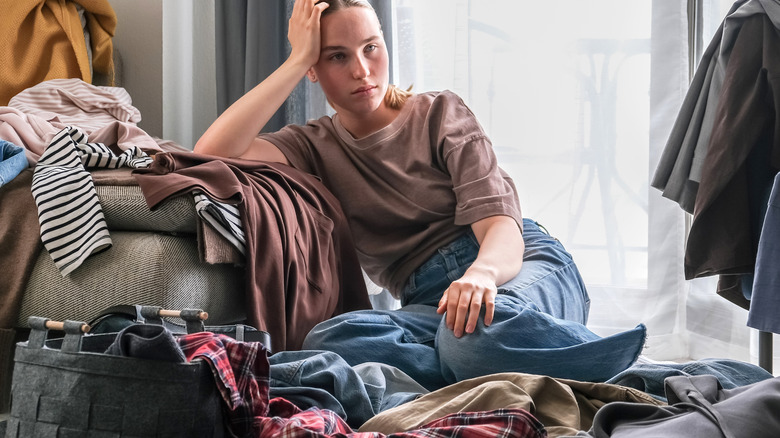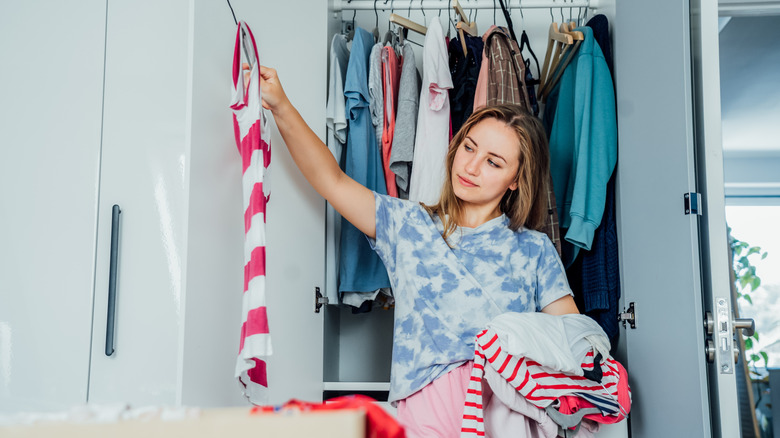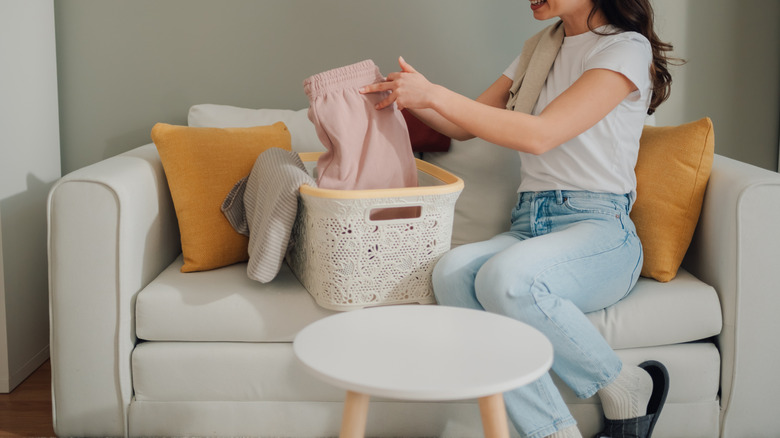Why The OHIO Decluttering Rule May Make Your Problem Worse, According To Our Expert
When it comes to organizing your space, there's no one-size-fits-all approach. In fact, there are multiple strategies you can try out to declutter your home. The OHIO decluttering rule is one such approach that's been gaining traction lately. But what does it entail, and should you try it out? To get these answers, House Digest got in touch with Jessica Litman, the founder of The Organized Mama, a blog dedicated to sharing ADHD-friendly organizing tips. She explains in her exclusive interview, "The only hold it once rule was originally called the one touch method. The idea of this method is that you only handle an item once to decide if you want to keep it or part with it. There is no wavering on if you are unsure if you use an item. You hold that item once and decide to keep or get rid of."
In theory, this might seem like a genius trick for a perfectly decluttered closet. After all, you just touch an item once and you have to decide its fate without second-guessing your decisions. However, Litman feels that it might make your problems worse. "My issue with this method for individuals with neurodivergence is that it relies on impulsive thinking to determine if an item is used." And this can be a recipe for disaster. She continues, "While impulsive thinking can be an ADHD superpower, when it comes to items in your home, it can lead to the removal of items you actually use because you are tired of looking at something that isn't put away in its proper place."
Reasons to skip the OHIO decluttering rule
Litman isn't a fan of the OHIO decluttering rule. Elaborating on the reasons in her exclusive chat with House Digest, she says, "An individual can get hung up on deciding whether or not to keep an item they call into decision paralysis. They can't decide so they can't move onto the next item because this idea is you hold it once." This won't just be a waste of your time; you might get overwhelmed and put off organization altogether. Luckily, there are other ways to declutter your bedroom if you're feeling overwhelmed.
With OHIO, you might throw away items you don't mean to. Relaying one such experience, Litman recalls, "I also had a client who hired a professional organizer to come help them organize their garage/storage area. This organizer used this rule but instead of individual items, they were doing boxes of things [to speed up the process]." But it didn't feel right, so the client contacted Litman. "When I came to help, we uncovered many of her father's items inside boxes that were labeled 'holiday' or 'camping'. These items were treasured pieces since her father had recently passed." As they went through each box, they could declutter things that weren't useful and keep the meaningful ones. So, "I don't recommend this rule to anyone," she says. It's because "not every brain can make quick decisions. The pressure can become overwhelming so your brain can easily fall into fight or flight." You may ruthlessly throw away things or cling to all your "precious" items like Gollum from "Lord of the Rings." Since these extremes reduce the technique's effectiveness, you're better off skipping it.
Alternatives to the OHIO decluttering rule
When prompted to list the decluttering methods she likes, Litman shares exclusively with House Digest, "For neurodivergent brains, the maybe bin or clutter basket is a great strategy as you remove the impulsive decision making from the OHIO rule. By collecting all the items in question, you are able to process what you need and what you don't need without the stress of removing something quickly." Basically, you move about your home and put anything that's out of place in the basket. You can then sort through the items at a later date and either put them back or throw them away. This decluttering rule works because "the maybe bin or clutter basket can be sorted through weekly without the hassle of quick decisions and impulsivity."
Assigning all your belongings a specific zone is another technique Litman swears by. This way, "you can put things back where they belong based on what zone that item is. This gives your home order without the stress." This is in stark contrast to the OHIO rule since "instead of making quick decisions on if something should stay or not, you find the zone that items belongs" to. However, to make this work, you can't be too rigid about the zones. They can be specific for certain actions like food prep, or you can have general ones for broader things like cooking. Go with whichever approach feels right and you're confident you can stick to in the long-term. But "if you don't have a zone for that item, that may be your sign it doesn't need to stay in your home," she concludes.


